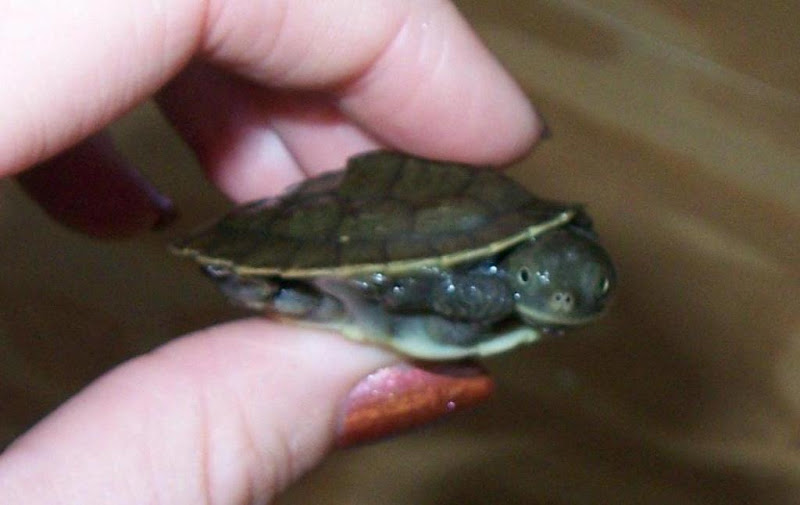Somebody, somewhere (I think it was a guy named Andrew, who I think, based on his email address, was a leader on the schoolies camp I went on – how random that he would be reading my blog ten years later) suggested I blog about having pet turtles more often. I think that’s a good idea. Pet turtles really are the coolest thing since pet rocks. And pet rocks were cool.
They do funny stuff. Like this:
Why you should get a turtle
- They’re exotic, a little left field, and people (especially kids) love them. They love watching them in the water, and the love watching them run around. Turtles have a funny way of running, with in built comedic value.
- Turtles are relatively low maintenance (eventually).
- Turtles are amphibious. Amphibians are awesome. So are reptiles. Turtles are both.
What you should know before you buy a turtle

A hatchling
Our turtles at a very young age
- There’s really no such thing as a penny turtle. You might remember having one as a child. What you had was a baby turtle that you probably grew out of. Our turtles started off the size of 50c pieces. Now they’re somewhere between the size of a bread plate and a dinner plate. They start small, but grow big.
- There’s a bit of set up cost involved – you need heat lamps, UV lights, docking platforms, and eventually a big tank. If you get two (which we did) there’s a good chance they’ll fight. And you’ll need extra space. Most of our problems have been caused by turtle fights.
- Get lots of Betadine. Betadine fixes everything. If your turtle has a wound, a fungal infection, a spot – Betadine will fix it.
- You can’t tell if young turtles are male or female. It’s a gender lottery.
- In some (many) Australian states you need a reptile license. You get these from the EPA in Queensland (or whatever they’re now called).
- Turtles bite. But only really in the water.
- If in doubt – take them out of the water – they only need to be in the water about an hour a day. They like being in the water. But sometimes their shells need time to dry out. For a long time ours slept in a box, wrapped in towels.
- The internet is your friend. There are heaps of good turtle resources online. I even bought ours on the internet and had them flown up to Townsville from Brisbane. When I was worried about one of them I turned to the internet for help. One of our turtles, Rosie (short for Roosevelt) was a little more sickly than the other, Frankie (short for Franklin) perhaps because Frankie used to bite her around the neck and take her for a death roll.
- Get a bucket to feed your turtle in. Turtle food stinks. And feeding them in their tank is a recipe for an incredibly stinky weekly clean up job.
Steps to getting your pet turtle
- Check licensing requirements where you live. Organise this first.
- Find a breeder – normally there’s enough time between contacting a breeder and getting the turtles to complete the next step.
- Set up the tank – you’ll need a dock of some sort (a rocky platform will do), a UV lamp to keep the shells healthy, and a heat lamp to keep their blood warm. A heater in the water is optional. They’ll get on their docks more if the water is cold (this is good for their shells too). You need to set up a tank a week before you put the turtle in it to get the chemical stuff happening properly. Apparently.
- Get some food – we use pellets and frozen turtle cubes (fish guts). We’ve tried with some cereal based pellets and they hate them. We also occasionally give them fruit and veggies. Which they seem to like. We put feeder fish in their tank, about 100 at a time. And they gradually disappear. But if you want some fun – kill one and hand feed it to the turtles and watch them go nuts trying to catch more.
- Get your turtles. Watch them swim. Enjoy some LOLs.
- Check your turtles regularly (especially when they’re young) for little blotchy spots on their shells and skin. These are bad – and should be treated pretty much straight away. Keeping them out of the water a bit will help.
- Take them for walks outside (but watch for birds). The sun is good for them.
- Wash your hands after touching them when they’re little. Turtles carry salmonella. And trust me. You don’t want that. Buy some of that reptile wash. Trust me. A week of gastro isn’t fun for anybody. They grow out of this after a while – I’m not sure at what point – but I don’t wash my hands anymore.
Some links
- I bought the turtles from a dealer on Aussie Pythons and Snakes (an all purpose reptile forum). I paid $65 a turtle two years ago. You’ll never find prices like that in a pet shop.
- Australian Freshwater Turtles is a forum filled with turtle enthusiasts including some very knowledgable breeders.
- The Australian Freshwater Turtle Conservation and Research Association fact sheet is a great resource for understanding how to keep and care for your little critters. Their website is pretty good too.
